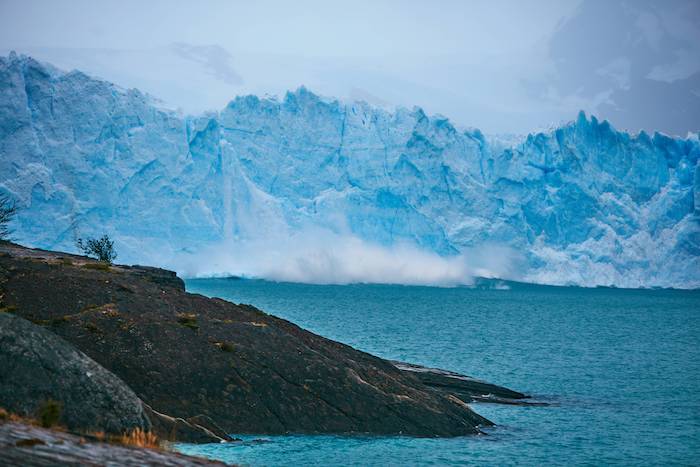
Through the clouds, the Greenland ice sheet seems as if flowing, soft hues of milky-white blending into shuttered grey, staccato rivers of ice, cut to pieces and breaking into turquoise waters.
The rivers that run from the heart of this land are vast and spacious and multiply endlessly, as glacial shifts grind new mountains out of land not glimpsed for millennia.
Miles below my window, the vast sweep of geological time is hastening to some unknown end to which my fellow passengers are unknowing witnesses, but also mute and uncomprehending contributors. For like so much else we take for granted, the emissions of this plane are themselves responsible for some small part of the glacial melt.
But few are looking, and the matter-of-factness before this wonder of the world makes it an awesome mirror to an increasingly broken humanity. The glacier breaks from its ice-white center, now this way now that, like some massive herd of buffalo, hurtling to a cliff, masses splitting off in their own directions, hesitant before thundering and growling over the edge.
Climate change cannot be framed by some iconic photograph, as in the fall of the Twin Towers or the raising of the flag at Iwo Jima. Climate change is everywhere and caused by virtually everything. It is present in the airplane’s turbulence vibrating my bones and in the mists outside the airplane window. But this view from the heavenly kingdom of clouds is as good as any.
Climate change asks that we step back and see things from afar and begin to think in epochal terms. It is a privileged position, comfortably Scandinavian, omnisciently Olympian in its detachment. It calls to mind a reason that, like the ice-sheet itself, is fast collapsing in the world today. But it is an imperial reason, like that of the enlightenment philosophers, that can all-too-easily mask its own contribution to suffering.
Climate change scars not only the mountains of Greenland but the faces of the Syrians who I recently met in a refugee camp in Greece. Many were undoubtedly victims of the seven-year drought, which collapsed agricultural yields in rural Syria, brought on, in part, by a changing climate. They migrated to the great cities of Aleppo and Damascus, only to confront an inequality that would stoke their rage and, with the explosion of the Arab Spring, break out in revolution. Now their outflow from Syria is like that of the glaciers, vast, epochal, and seemingly unending.
These changes remind me of a most unusual autobiography, An African in Greenland, by Tété Michél Kpomassie, a West African villager, who sees a photo of Greenland, as a child, in the 1950s and dreams of migrating there. After journeying over a decade, across much of Africa and Europe, the rarity of his blackness makes him a sort of celebrity in Greenland. Then this likely subject of anthropological investigation turns his gaze on the Greenlanders and he begins to write about their cultural habits and institutions. It is pure exotica at its best, the native subject turned objective observer, an anthropological reorientation that reveals as much about the imperial gaze as it does its subject.
Over the course of the next century, we are likely to see many poorer subjects turned objective observers of the West, as vast historical forces sweep populations across the world. The Syrians will bring their own viewpoint to Europe, much as the Jews did millennia before them. These movements will flow into one another, climate change into revolution, revolution into refugee crisis, refugee crisis into the new global fascism, each a global cause and effect.
Each movement will upend the way we see the world. The eco-philosopher, Timothy Morton, calls them hyper-objects, phenomena whose outline is either too big or too small to see, but which technology and global interconnectedness have made salient. The refugee crisis and climate change can be treated as objects impinging on our lives, but they are too big to grasp in their entirety. And before their greatness, most of us do not know how to respond.
To make sense of them we must see them through a wider lens. But as global crises mount there is a danger our gaze will narrow. For the stress of global crises tends to make people retreat into smaller worlds: fundamentalism, fascism, radical Islamism, eco-romanticism. In this way, climate change may paradoxically undermine the very sense of security needed to understand it. Climate change did not cause the violence in Darfur and Northern Nigeria, but it did play a part. And it is quite possible that as global temperature increase(s), the kind of state failures to which it contributes will make it ever more difficult to find the engaged distance needed to see its totality and act.
As the plane now makes its way over Canada, the glacial scars seem like the claw marks of some massive prehistoric beast, deep grooves sweeping for seemingly hundreds of miles. Here the melting of glacier into the Atlantic was once so sudden as to shut down the North Atlantic Current, which brings warm waters from the Southern Hemisphere up the East Coast, making otherwise unbearable European latitudes livable. The shutdown is highly unlikely to occur again in our time, but if it does it will plunge Europe into an ice age. It is unlikely, but with forces too big to grasp, we can never feel certain.
Americans and Europeans would do well to worry about bigger things than the influx of refugees from Syria. As one of the refugees from the camp told me, he wanted the world to know that they would integrate, just give them time. Continental shifts are grinding under our feet. It may take some distance from which to see their flows, but the movements are unmistakable. We are going to have to learn to live with quite a lot in the 21st century. Learning to live with climate change means seeing what truly matters. Perhaps we will find some solace in holding the wider view that comprehending it requires.
~
Theo is the author of The Inner Climate: Global Warming from the Inside Out, a book of interviews with leading climate thinkers, like Paul Ehrlich and Frances Moore Lappé. If you liked this article, please friend him on Facebook and join the dialogue.
~
Author: Theo Horesh
Images: Pexels
Editor: Travis May

 Share on bsky
Share on bsky






Read 0 comments and reply